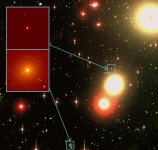How many stars fit in a light year?
Sunday, February 15, 2009
Within our Galaxy, we are accustomed to the idea that even the nearest stars light years away from us. A team of scientists has come to the conclusion that this situation was completely different in the young universe. In particular, a recently discovered class of galaxies, called the Ultra Compact Dwarfs or UCD systems would star together in huge numbers of businesses - perhaps one million stars per cubic light year!
Ultra Compact Dwarfs or UCD's discovered in 1999 and the smallest galaxies we know. Although they are daily standards still enormous, they are with a diameter of about 60 light-year average is 1500 times smaller than our Milky Way. Astronomers suspect that UCD's formed in the young universe as a by-product of the collision between normal galaxies.
Now know UCD's a higher mass than can be derived on the basis of the stars they contain. This is in most types of galaxies the case and this "missing mass" is usually attributed to dark matter. However, UCD's so small that they are never sufficient to contain dark matter to explain this mass. Instead, the team of scientists to an alternative conclusion.
The astronomers believe that any UCD ever a huge density of stars contains, perhaps 1 million stars per cubic light years (a huge difference in the density in the Milky Way, which is only 1 star per cubic light year). These stars would have been closed, which sometimes clashes together and melting could be made. These are stars with a much higher mass, providing quickly exploded and dense left seem to have: neutron stars and black holes. Over time, the armada of massive stars turn into a collection of weak light and dark objects. That means that most of the stellar mass of UCD are still present, although in a form that makes them invisible to our telescopes.
Though today's dull and dark, would UCD in the distant past have been around spectacular. A collection of stars with such a huge high density is not comparable to what we can observe today - anywhere. For an observer on a (hypothetical) planet within a UCD, the night sky as bright as the Earth's daytime sky.
Source: Royal Astronomical Society
Sunday, February 15, 2009
Within our Galaxy, we are accustomed to the idea that even the nearest stars light years away from us. A team of scientists has come to the conclusion that this situation was completely different in the young universe. In particular, a recently discovered class of galaxies, called the Ultra Compact Dwarfs or UCD systems would star together in huge numbers of businesses - perhaps one million stars per cubic light year!
Ultra Compact Dwarfs or UCD's discovered in 1999 and the smallest galaxies we know. Although they are daily standards still enormous, they are with a diameter of about 60 light-year average is 1500 times smaller than our Milky Way. Astronomers suspect that UCD's formed in the young universe as a by-product of the collision between normal galaxies.
Now know UCD's a higher mass than can be derived on the basis of the stars they contain. This is in most types of galaxies the case and this "missing mass" is usually attributed to dark matter. However, UCD's so small that they are never sufficient to contain dark matter to explain this mass. Instead, the team of scientists to an alternative conclusion.
The astronomers believe that any UCD ever a huge density of stars contains, perhaps 1 million stars per cubic light years (a huge difference in the density in the Milky Way, which is only 1 star per cubic light year). These stars would have been closed, which sometimes clashes together and melting could be made. These are stars with a much higher mass, providing quickly exploded and dense left seem to have: neutron stars and black holes. Over time, the armada of massive stars turn into a collection of weak light and dark objects. That means that most of the stellar mass of UCD are still present, although in a form that makes them invisible to our telescopes.
Though today's dull and dark, would UCD in the distant past have been around spectacular. A collection of stars with such a huge high density is not comparable to what we can observe today - anywhere. For an observer on a (hypothetical) planet within a UCD, the night sky as bright as the Earth's daytime sky.
Source: Royal Astronomical Society

